Understanding the Worth of South Sea Pearls
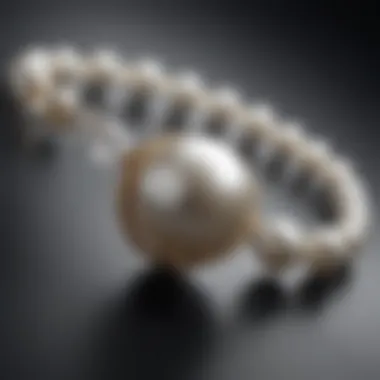
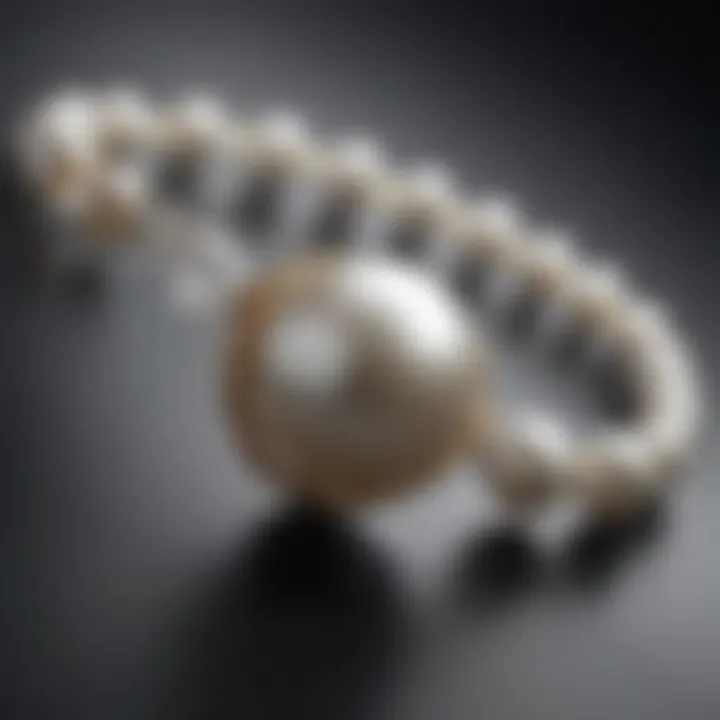
Intro
In the shimmering world of gemstones, South Sea pearls hold a distinguished place, cherished for their unrivaled beauty and cultural significance. These lustrous gems, born from the depths of the ocean, often evoke a sense of wonder and reverence. As we journey through this comprehensive examination, we’ll explore their enchanting characteristics, market dynamics, and the layers that add to their intrinsic value, guiding enthusiasts and collectors alike.
Gemstone Overview
Definition and Characteristics
South Sea pearls are among the largest and most sought-after pearls in the world. Renowned for their size, these pearls measure between 9 to 20 millimeters. They naturally exude a radiant luster, a trait that’s pivotal to their desirability. The unique colors vary from white to gold, each shade telling its own story—a reflection of the waters in which they are cultivated.
It’s worth noting that the color of South Sea pearls is influenced largely by the type of oyster that produces them, primarily the Pinctada maxima.
Characteristics that define South Sea pearls include:
- Luster: The glow emanating from the pearl's surface.
- Surface Quality: A smooth, blemish-free surface is highly prized.
- Shape: Ideally spherical, but baroque shapes are also appreciated for their uniqueness.
- Color: Ranges from silvery white to deep gold.
Classification of Gemstones
When discussing gemstones, classification helps to understand their origins and qualities. South Sea pearls can be categorized based on various factors, including:
- Type of Oyster: Most South Sea pearls come from the silver-lipped or gold-lipped oysters.
- Geographical Origin: They are primarily sourced from Australia, Indonesia, and the Philippines.
- Culturing Method: There are natural and cultured varieties; cultured South Sea pearls are more prevalent in the market today.
These classifications not only help in appreciating the gems themselves but also play an essential role in determining their value.
Historical Significance
Ancient Uses and Cultural Importance
The allure of pearls has not faded over centuries. In ancient times, they were considered symbols of wealth and power. Emperors and royals adorned themselves with South Sea pearls for not just their decorative appeal, but also for the status they represented. They were often linked to the divine, seen as gifts from the sea.
Myths and Legends Surrounding Gemstones
Various cultures have woven myths around pearls, including South Sea varieties. For instance, in some Southeast Asian cultures, pearls are believed to possess protective qualities, shielding their wearers from harm. The tales of beautiful mermaids luring sailors to their doom, clutching precious pearls, capture the imagination. This interplay of history and mythology enriches the narrative surrounding these exquisite treasures.
Understanding the historical significance of South Sea pearls enhances their value and helps collectors appreciate the rich tapestry of stories that accompany these gems.
An Preface to South Sea Pearls
South Sea pearls, often seen as the epitome of luxury in the world of pearls, deserve to be in the spotlight. Recognized for their stunning beauty and unique characteristics, these gems have captured the hearts of many gem enthusiasts and collectors alike. This section introduces the significance of South Sea pearls, setting the stage for a deeper exploration throughout the article.
The allure of South Sea pearls goes beyond their visual appeal. They come from specific regions, mainly the waters of Australia, Indonesia, and the Philippines. Their geographical origin plays a crucial role in their value and desirability. The cultivation process also adds layers to their mystique and worth. Without a doubt, understanding South Sea pearls means diving into the interplay between nature and craftsmanship.
Moreover, it is essential to recognize their historical context. South Sea pearls have been prized possessions for centuries, often symbolizing wealth and status in various cultures. Their significance isn't merely surface-level; they are interwoven with tales of exploration and trade. This backdrop makes South Sea pearls not just a commodity but a piece of history and tradition.
Defining South Sea Pearls
South Sea pearls are produced primarily by the Pinctada maxima oyster, which is known for creating the largest pearls across the globe. These pearls typically range in size, often exceeding ten millimeters, and can reach up to twenty-five millimeters in diameter. The charm of South Sea pearls lies in their creamy color spectrum; they can come in shades of white, gold, and silver, but their distinct luster and surface quality set them apart from other types of pearls.
The classification of South Sea pearls also includes factors such as nacre thickness and shape. Unlike other pearls that are often more uniform in appearance, South Sea pearls display a more varied array of shapes—from perfectly round to Baroque forms—making each piece unique. This uniqueness adds to their desirability, boosting their appeal among high-end jewelry designers and collectors.
Historical Context
The journey of South Sea pearls goes back to ancient civilizations. They have been esteemed not just as jewelry but as currency and gifts, often exchanged among royalty. In the past, the presence of South Sea pearls often meant the difference between social standing and anonymity. Monarchs and explorers prized these pearls, fueling a robust trade that connected distant lands.
One notable episode in their history is the exploration by the Spanish in the Pacific during the 16th century. They discovered the lustrous pearls and quickly recognized their potential profitability. As tales of these gorgeous gems spread, so did the interest from Europe, which established a strong market for them.
In summary, an introduction to South Sea pearls unveils a world where beauty, history, and heritage intermingle. This understanding serves as the underpinning for exploring their origins, distinctive characteristics, market dynamics, and the broader implications of their existence in today’s world.
The Origins and Cultivation
Understanding the origins and cultivation of South Sea pearls is crucial to appreciating their value in the world of fine jewelry. South Sea pearls, primarily sourced from the Pinctada maxima oyster found in the warm waters of the Indian and Pacific Oceans, hold a unique status due to their sheer size, luster, and exquisite colors. Their cultivation is not merely a process but a refined art—one that reflects the delicate balance of nature and human craft.
Geographic Distribution
The geographic distribution of South Sea pearls is tightly linked to their quality and characteristics. They typically flourish in a narrow band of tropical and sub-tropical regions, mainly along the coasts of Australia, Indonesia, Myanmar, and the Philippines. Each of these areas contributes distinct traits to the pearls cultivated within its waters:
- Australia: Known for producing the largest and arguably the highest quality pearls, Australian South Sea pearls exhibit a range of white to golden hues. The Australian climate and rich marine life contribute significantly to this.
- Indonesia: This region yields pearls that often have a more pronounced gold color, prized for their warmth and richness. The natural conditions and nurturing waters play roles here, affecting the overall growth cycle of the pearls.
- Myanmar and the Philippines: Both areas present unique environmental factors that influence the growth and cultivation practices. Pearls from these regions can display striking overtones of pink, rose, or even silver.
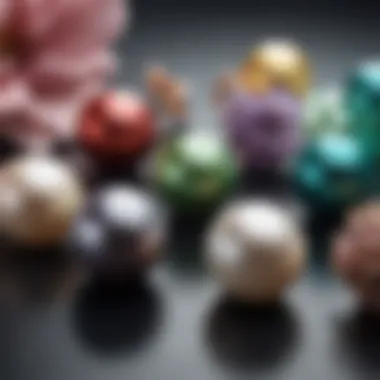

The distinct gems produced in these locations often fetch different prices in the market due to their varying aesthetic qualities and the reputation of their origins.
Cultivation Techniques
Pearl cultivation involves a specific set of techniques that have evolved over centuries, each step carefully calibrated to ensure the health of the oysters and, consequently, the pearls they produce. Some key techniques include:
- Nucleation: This process involves implanting a small bead and a piece of mantle tissue into the oyster, stimulating it to form a pearl. The choice of bead size and tissue plays a significant role in the eventual pearl's size and shape.
- Farm Management: Pearl farms operate much like delicate ecosystems. Farmers must monitor water quality, temperature, and even the health of the oysters meticulously. Seasonal changes often dictate when and how care is administered.
- Harvesting: Once the pearls reach maturity, typically over a period of two to four years, they are carefully harvested. This involves removing the oysters from their underwater homes, assessing each pearl's quality, and returning the non-productive oysters to the sea to replenish the farm.
Each of these cultivation methods adds to the pearls' uniqueness, resulting in jewels that not only shine with unparalleled beauty but also tell a story of their journey from the ocean depths to the jewelry collector's shelf.
"South Sea pearls' unique origins and sophisticated cultivation techniques make them a coveted luxury in the gemstone world."
With this in mind, the origins and cultivation are fundamental in determining the intrinsic value of South Sea pearls. Their geographical heritage and the mastery involved in raising them underline their status as exquisite gems cherished across cultures.
Distinctive Characteristics of South Sea Pearls
South Sea pearls are renowned for their beauty and uniqueness. Their distinct characteristics set them apart in the dazzling world of gems. These particular attributes not only increase their allure but also contribute to their value. Understanding these traits is crucial for enthusiasts, collectors, and anyone interested in the pearl market.
Size and Shape
One of the standout qualities of South Sea pearls is their size. Generally larger than many other types of pearls, South Sea pearls can range from 9 mm to a staggering 20 mm or more. This generous size often signifies quality and desirability in the market. Additionally, the shape of these pearls plays a significant role; while round pearls dominate the scene, you can also find baroque, oval, and teardrop shapes.
Each shape tells a different story. Round pearls, often viewed as the epitome of perfection, are rare and carry a higher price tag. The baroque pearls, on the other hand, with their unique and irregular shapes, may appeal to those looking for something one-of-a-kind. Their variation not only adds to the diversity of the market but also allows collectors to choose pieces that resonate with their personal aesthetics.
Color Variations
The color range of South Sea pearls can be described as a feast for the eyes. Predominantly, these pearls exhibit shades of white, silver, and gold, but the color palette stretches far beyond those hues. Imagine deep shades like champagne, rose, and even deep blue.
Gold South Sea pearls are often the most coveted, sourced mainly from the Pinctada maxima oyster. The golden tones range from pale to rich, deep gold, which can greatly influence market value. Silver pearls, particularly those with subtle undertones, provide a unique aesthetic that can complement a variety of jewelry designs.
This rich color variety not only amplifies their desirability but also provides fascinating opportunities for jewelers and designers to create stunning pieces. A pearl’s color can significantly affect its value, as some shades are rarer and, thus, more sought after.
Luster and Surface Quality
When discussing pearls, luster is akin to how a diamond sparkles. The brilliant reflection of light on the pearl’s surface is a key factor in determining its overall quality. South Sea pearls are celebrated for their exceptional luster, often described as a soft, mirror-like shine that is both radiant and inviting.
However, luster alone is not the sole indicator of worth. The surface quality of the pearl also matters. Ideally, one seeks a pearl that is free from blemishes and imperfections. Still, in the world of South Sea pearls, some buyers find charm in pearls with slight surface variations, which imbue a piece with character.
In summary, discerning collectors need to carefully assess both luster and surface quality. A pearl with extraordinary luster and minimal blemishes is typically valued higher.
"A pearl is more than just a gem; it's a story, a journey from the depths of the sea to the elegance of human adornment."
These distinctive characteristics make South Sea pearls not just precious gems, but cherished treasures. They're pivotal in crafting extraordinary jewelry pieces that stand out in elegance and character.
Market Dynamics of South Sea Pearls
Understanding the market dynamics surrounding South Sea pearls is crucial for anyone immersed in this fascinating world. These pearls are not only remarkable for their inherent beauty but also for the economic factors that drive their value. As we dive into pricing elements, current market movements, and the characteristics that set these pearls apart from others, collectors, jewelers, and enthusiasts will gain insights essential for navigating the complex landscape of South Sea pearl commerce.
Pricing Factors
Pricing in the world of South Sea pearls is influenced by a variety of factors that hinge upon quality assessments, demand and supply, and peer comparisons. Each plays a pivotal role in determining how these pearls are valued in the marketplace.
Quality Assessments
Quality assessments are at the heart of pricing South Sea pearls. These assessments take into account several characteristics, such as luster, surface quality, shape, and size. Luster refers to how reflective the pearl is, and a high-quality pearl will have a mirror-like sheen that catches the eye. The importance of surface quality cannot be overstated, either; pearls with few blemishes are often considered superior.
Moreover, professionals in the industry often follow guidelines set by organizations like the Gemological Institute of America when evaluating quality. When the pearl checks out well against these criteria, buyers are more willing to pay top price. It's a benefit for sellers looking to negotiate a good deal.
However, this detailed assessment can be somewhat subjective. Each evaluator might prioritize different aspects, which could lead to variances in perceived value. As such, having a well-qualified appraiser is vital when investing in or selling South Sea pearls.
Market Demand and Supply
Market demand and supply play a significant role in the pricing game as well. South Sea pearls are rare—especially the most sought-after qualities, which results in a somewhat volatile pricing structure. When demand spikes, especially in niche markets or regions-known for luxury goods, prices can soar.
The unique factor here is that while harvests can be controlled, natural influences affecting the oyster populations lead to irregular supply patterns. This erratic availability can create a bidding war among collectors and retailers when stocks are low, significantly driving up prices.
On the flip side, if supply exceeds demand—perhaps due to an increase in pearl farming or sudden fluctuations in consumer interest—prices can plummet. Thus, understanding market trends becomes essential for anyone looking to invest.
Peer Comparisons
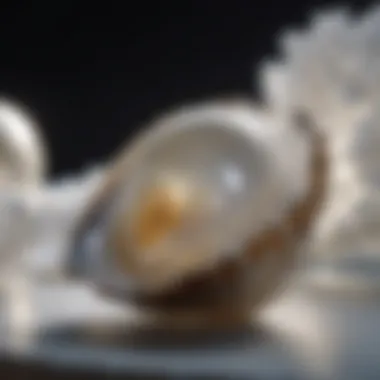
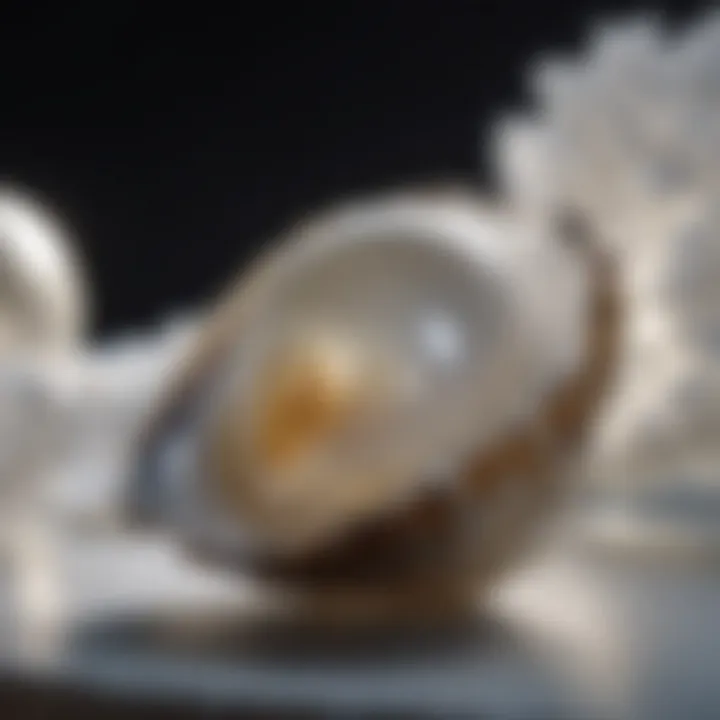
Peer comparisons refer to the practice of evaluating South Sea pearls against other types of pearls, like Tahitian and Akoya varieties. Jewelers often use these comparisons as a benchmark to highlight the unique features of South Sea pearls. The distinction is important as it not only shapes pricing strategies but also shapes buyers' perceptions regarding worth and desirability.
In this context, South Sea pearls tend to be viewed as luxury items compared to other types of pearls because they are larger and often possess remarkable luster. This characteristic heightens their status and makes them a favorable choice for consumers looking for investment-grade pieces. However, there’s an ongoing debate regarding their long-term value compared to other pearl types. Some may argue that Akoya pearls are more affordable and thus a better starting point for novice collectors.
Current Market Trends
The landscape of South Sea pearls constantly evolves, and current market trends reflect shifting consumer tastes and economic realities. Recently, a growing appreciation for sustainable and ethical sourcing has started to influence buying behaviors. Many consumers are now inclined to support brands and vendors that prioritize environmentally friendly practices in pearl farming.
Additionally, reports suggest a rise in the popularity of customized pearl jewelry, allowing collectors to invest not just in pearls themselves, but also in pieces crafted to their personal taste.
As such, engaging with these trends may provide savvy investors an edge, fostering connections to designers or platforms that emphasize quality while aligning with current consumer values.
The market dynamics surrounding South Sea pearls are intricate but vitally important for both seasoned collectors and those new to this exquisite realm. Understanding these principles can help navigate investment opportunities more effectively.
Comparison with Other Pearls
When we think about pearls, the mind often wanders to a few familiar names: Tahitian, Akoya, and Freshwater pearls. While South Sea pearls have carved a niche of their own, understanding their position in the broader landscape of pearls offers valuable insights into their uniqueness and desirability.
South Sea pearls, known for their larger size and lustrous quality, sometimes find themselves pitted against other pearl types in terms of market value, aesthetic beauty, and cultural significance. By comparing these pearls, enthusiasts and collectors can gain a clearer picture of what truly sets South Sea pearls apart.
Tahitian Pearls
Tahitian pearls, often dubbed the "black pearls," originate from the black-lipped oyster found in the lagoons of French Polynesia. These pearls are celebrated for their deep hues, which range from silver to green, brown, and even blue. Although both Tahitian and South Sea pearls can grow to impressive sizes, the former generally tends to be smaller, with an average size between 8 to 14 mm.
In addition to size, the surface quality of Tahitian pearls can vary significantly. They may exhibit irregularities or inclusions that some collectors see as charming, while others prefer the immaculate surfaces typical of South Sea pearls. An impressive luster characterizes both, however, with South Sea pearls typically achieving a renowned satiny finish that can be hard to match.
Another point of distinction lies in the pricing. Tahitian pearls, due to their dramatic colors and unique aesthetic appeal, can fetch high prices but often do not reach the same premium levels as South Sea pearls. The rarity of specific colors can make Tahitian pearls valuable, yet the opulence and surface perfection of South Sea pearls often reign supreme in the luxury market.
Akoya Pearls
Akoya pearls are perhaps the most recognized pearls in fine jewelry circles. Generally smaller than their South Sea counterparts, they range from 6 to 9 mm. These pearls are cultivated in Japan and are cherished for their high-luster and round shapes. They often come with a creamy white base, occasionally shaded with rose or cream overtone.
While the luster of Akoya pearls is bright, South Sea pearls often take the cake with their deeper, more complex luster and larger size. Collectors tend to prefer South Sea pearls due to these desirable traits. In terms of pricing, Akoya pearls might be more accessible for entry-level buyers, while South Sea pearls tend to cater to those seeking premium jewelry options.
Freshwater Pearls
Freshwater pearls are often regarded as the "affordable" option in the pearl realm. Primarily cultivated in freshwater mussels, they often vary greatly in shape and size but typically range from 5 to 11 mm. Unlike South Sea pearls, which primarily come in white and gold tones, freshwater pearls can present a rainbow of colors including lavender, peach, and even metallic shades.
From a collector’s standpoint, the overall quality and luster of freshwater pearls may not rival South Sea pearls, but their versatility in style and color allows for creative applications in jewelry design. Pricing serves as a stark contrast, with freshwater pearls usually more budget-friendly than South Sea pearls, making them accessible for those new to pearl collecting.
By understanding these distinctions and nuances, pearl enthusiasts and collectors can make informed decisions that align with their aesthetic preferences and investment goals.
Cultural Significance of South Sea Pearls
The allure of South Sea pearls transcends mere aesthetics; they embody cultural tales, historical significance, and social dynamics. Their rich narrative weaves through various societies, transforming them from simple objects of beauty into symbols of status and cultural heritage.
Symbolism and Status
In many cultures, South Sea pearls are revered not only for their beauty but also for the prestige associated with them. From the ancient civilizations of Mesopotamia to the modern elite, these pearls signify wealth, success, and nobility. For instance, in the royal families of Southeast Asia, wearing pearls is a longstanding tradition, often symbolizing purity and lineage. This association of pearls with power is not anecdotal. Just look at how various fashion icons flaunt South Sea pearls, making them the centerpiece of their ensembles, subtly communicating their social standing.
Moreover, the value attached to these pearls is closely linked to the stories they tell. Each pearl carries a history, reflecting the environment in which it was cultivated. The darker shades or unusual colors sometimes hold specific meanings, often tied to local beliefs. In Polynesian cultures, for instance, the color gold represents prosperity and life. South Sea pearls are not merely fashion statements; they are, in essence, cultural artifacts embodying the tales and traditions of generations.
Artistic Representations
Beyond their status as symbols of wealth, South Sea pearls have inspired numerous artistic representations. Across various mediums—whether in paintings, sculptures, or jewelry design—these pearls have held a place of honor. Artists often use these pearls to embody purity, elegance, and femininity. The ancient art of jewelry-making sees intricate designs where delicate South Sea pearls are central, often paired with gold and intricate metalwork that enhances their beauty.
Take, for example, the celebrated jewelry designer, Paloma Picasso. Her collection features South Sea pearls as central elements, using them to create striking contrasts between different materials. This not only emphasizes the pearls' shimmering luster but also creates an elegant narrative that celebrates the harmonious blend of nature and craftsmanship.
Furthermore, literature has also highlighted South Sea pearls, often using them as metaphors for deeper meanings—spiritual richness, vulnerability, and transformation. As such, South Sea pearls serve as a bridge between realms; they are both tangible and intangible, linking physical beauty with deeper cultural significance.
"South Sea pearls are more than mere adornments; they are capsules of culture, infused with meanings that resonate through history."
In sum, the cultural significance of South Sea pearls is multifaceted. They represent more than just material value; their symbolism, linked to status and artistic expression, gives them a weight that resonates with gemstone enthusiasts and collectors alike. This profound meaning transforms the simple act of wearing pearls into a rich, cultural experience.
Ethical Considerations in Pearl Sourcing
The conversation around the sourcing of South Sea pearls increasingly highlights the dimension of ethical responsibility. As consumers become more conscious about the origin of luxury items, understanding the ethical impact of pearl sourcing has become crucial. This not only shapes purchasing decisions but also has a significant influence on the sustainability of the industry as a whole. By supporting ethical practices, buyers contribute to a broader movement that seeks to protect marine ecosystems and empower local communities.
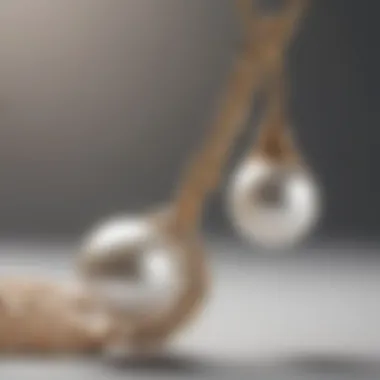
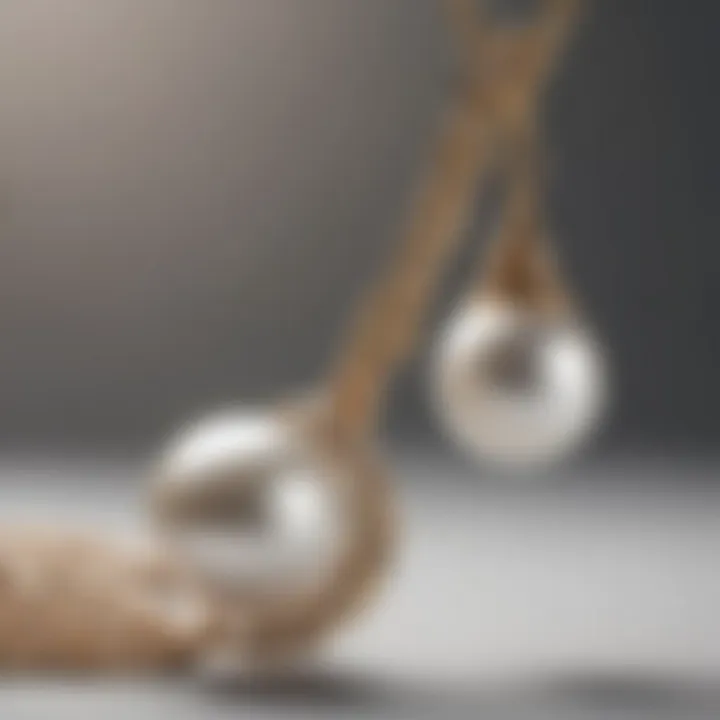
Sustainable Practices
Sustainable practices in pearl farming are essential for preserving the delicate marine ecology while ensuring the livelihood of those involved in these businesses. Here are some key sustainable methods employed in the South Sea pearl industry:
- Environmentally-friendly aquaculture: Many pearl farms are adopting practices that minimize environmental impact. This includes avoiding the use of detrimental chemicals that can harm marine life.
- Onshore farming: Conducting pearl farming operations in controlled, onshore environments helps to reduce stress on ocean ecosystems, providing a stable habitat for oysters without depleting wild stocks.
- Responsible sourcing: Sustainable farms often prioritize sourcing their seed oysters from responsible breeders that aim to maintain genetic diversity and avoid overgrazing the natural populations. This ensures that there is a balance between production and conservation.
In summary, the integration of sustainable practices not only leads to high-quality pearls but also enhances the overall long-term viability of the pearl farming industry. These practices are a step towards securing a healthy marine environment for future generations.
Impact on Local Communities
The effects of pearl farming on local communities can be profound and multifaceted. When conducted responsibly, pearl farming can provide significant benefits, but it also bears certain risks. Understanding these impacts helps in ensuring that the communities involved are sustained and not exploited:
- Economic empowerment: Successful pearl farms can create jobs and provide a steady income for local families, lifting whole communities out of poverty. This is especially relevant in regions where alternative livelihoods may be scarce.
- Cultural preservation: Pearls hold deep cultural significance for many Pacific island communities. Ethical sourcing can protect traditional practices and reinforce local identities, allowing these communities to share their heritage with the world.
- Challenges: On the flip side, some pearl farming operations can lead to ecological degradation, which in turn can threaten local fisheries and tourism. Infringements on land rights and labor exploitation are also issues that remain pertinent.
Investing in the ethical sourcing of South Sea pearls means investing in the communities that depend on them. It's crucial to support businesses that prioritize evidence-based practices, respect for local cultures, and protection for the environment.
Investing in South Sea Pearls
Investing in South Sea pearls is not just a transaction—it's a passport into a world of elegance and rarity. Unlike standard investments, this pursuit connects directly to the beauty of nature and craftsmanship. With their stunning luster and sizable presence, these pearls often command prices that reflect their remarkable allure. Their value isn’t just monetary; it's intertwined with culture and history. The scarce availability of South Sea pearls, particularly those cultivated in prime environments, amplifies their appeal and marketability.
Factors to Consider
When considering South Sea pearls as an investment, certain factors should dominate your thought process. It isn't just about the surface beauty; deeper layers contribute to both desirability and value. Here are the pivotal elements to keep in mind:
- Quality of the Pearl: This includes attributes like luster, surface quality, and nacre thickness. The better the quality, the higher the investment return.
- Size Matters: Generally, the larger the pearl, the more valuable it is. South Sea pearls typically range from 9mm to 20mm, with larger sizes fetching premium prices.
- Color: Variety in color can significantly affect value. While white and golden hues dominate, deeper colors like silver or champagne can be more sought after.
- Shape: Round pearls remain the most prized, but baroque shapes can also command respect in niche markets. Buyers often appreciate the uniqueness of irregular shapes.
- Source and Authenticity: Knowing where the pearls come from and ensuring they are genuine can significantly impact the investment’s future potential.
- Market Trends: Prior knowledge of current trends helps anticipate value fluctuations. Being in tune with supply and demand will help optimize timing for buying or selling.
In sum, the right South Sea pearl investment showcases not just aesthetic beauty, but also an intelligent approach towards long-term value potential. Understanding these elements is the first step to making astute choices.
Understanding Appraisals
Appraising South Sea pearls can often feel like navigating a labyrinth. However, a proper appraisal is crucial for accurately capturing their worth. The process itself involves various specialists, each assessing different criteria. Here's how this unfolds:
- Expert Assessments: Gemologists evaluate pearls based on industry standards. Their expertise forms the backbone of the appraisal process. Having an experienced appraiser by your side can give confidence in knowing whether you're getting a fair deal.
- Documentation: Proper documentation, including certificates of authenticity and quality reports, is essential. Look for descriptions detailing luster, size, shape, and color in these papers.
- Market Comparisons: Appraisers often use comparative metrics, looking at recent sales of similar-quality pearls. This can help highlight how your investment measures up in current market conditions.
- Rarity Evaluation: Because South Sea pearls are relatively rare, the appraiser will factor in the rarity of particular pearls, influencing their market value.
- Appraisal Frequency: Market dynamics shift occasionally, so having your pearls re-appraised regularly is good practice. It keeps you in the know regarding the market value, helping you strategize future actions.
Understanding appraisals can transform the way you perceive and manage your pearl investments, equipping you with knowledge to navigate this lucrative market effectively.
"The true value of a South Sea pearl lies not in what it costs, but in the story it embodies and the care with which it is nurtured."
As the market landscape evolves, investors should stay informed about the intricate factors influencing value, ensuring their investments not only retain appreciation but also evoke timeless admiration.
Care and Maintenance of South Sea Pearls
Taking care of South Sea pearls is essential to preserve their beauty and value. These gems are unique, and proper maintenance ensures they remain lustrous over time. As the saying goes, "A stitch in time saves nine," which fits when you consider how a little effort can prevent larger, more costly issues in the long run. Keeping South Sea pearls clean and stored correctly goes a long way to maintaining their charm.
Cleaning Techniques
Cleaning South Sea pearls isn’t about scrubbing them with harsh chemicals. Instead, it's more akin to treating them gently, like you would handle a precious flower. Here are some effective techniques to keep your pearls sparkling:
- Use a soft cloth: After wearing your pearl jewelry, wipe it down with a clean, soft cloth to remove natural oils, sweat, and dirt. This prevents buildup that can dull the surface over time.
- Mild soap solution: For deeper cleaning, create a solution of lukewarm water and mild soap. Dip a soft cloth into this solution, gently wipe the pearls, and then rinse them with fresh water. Make sure to dry them properly afterward.
- Avoid ultrasonic cleaners: While these devices work wonders for many gemstones, they can be too harsh for pearls. The vibrations can cause surface scratches and weaken the nacre.
"Maintenance is the key to longevity, especially for delicate pieces like South Sea pearls.”
Storage Recommendations
Storage is crucial in ensuring your pearls don’t come into contact with materials that may scratch them or affect their luster. They deserve a cozy spot of their own. Here are recommended practices for storing South Sea pearls:
- Separate from other jewelry: When storing, always keep your pearls in a separate compartment from metal or other gems. A soft pouch or a lined jewelry box will do wonders to keep them safe from scratches.
- Avoid plastic bags: These can harbor moisture, which can lead to mold or damage. Instead, opt for breathable fabric pouches.
- Keep away from direct sunlight: Prolonged exposure to sunlight can fade the colors of your pearls. Store them in a cool, dark place, much like storing fine wine.
Caring for South Sea pearls is more than just cleaning; it’s about creating an environment where these jewels can maintain their brilliance. By following these cleaning and storage techniques, you're not just taking care of South Sea pearls; you're ensuring that they continue to tell their story for generations to come.
Ending
As we draw the curtain on our exploration of South Sea pearls, it's essential to consider the broader implications and significance these exquisite gems hold. Not merely objects of beauty, South Sea pearls embody a storied legacy and intricate craftsmanship, which adds to their allure. For gemstone enthusiasts and collectors, understanding the nuances of South Sea pearls is not just about aesthetics; it also encompasses appreciation for their cultural and economic value.
Key Takeaways
- Unique Origins and Cultivation: South Sea pearls are primarily produced in the warm waters of Australia, the Philippines, and Indonesia. Their cultivation is labor-intensive and relies on sustainable practices that protect marine ecosystems.
- Distinctive Characteristics: These pearls are renowned for their large sizes, breathtaking luster, and broad range of colors, from pristine white to rich gold.
- Market Dynamics: Prices are influenced by factors like quality, demand, and seasonal variations. Awareness of these can help collectors make informed decisions.
- Cultural Significance: Historically, these pearls have symbolized wealth and status, often featured in artifacts and jewelry that have made their mark through cultures.
Overall, when considering a South Sea pearl, whether for investment or personal joy, it’s crucial to grasp these elements thoroughly.
Future Outlook
The future of South Sea pearls seems bright as demand remains steady among collectors and jewelry enthusiasts. Factors contributing to this positive outlook include:
- Sustainability Focus: As consumers grow increasingly concerned about sustainable sourcing, pearls cultivated with environmentally friendly methods will likely gain more traction.
- Market Trends: The merging of traditional craftsmanship with modern design trends will ensure that South Sea pearls remain relevant in high-end jewelry markets.
- Digital Engagement: The rise of online platforms for buying and selling pearls offers an expansive market for both new and seasoned collectors, making it easier to find rarer pieces and build one's collection.







